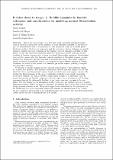| dc.contributor.author | Suckale, Jenny | |
| dc.contributor.author | Nave, Jean-Christophe | |
| dc.contributor.author | Hager, Bradford H | |
| dc.contributor.author | Elkins Tanton, Linda T. | |
| dc.date.accessioned | 2011-04-28T15:42:29Z | |
| dc.date.available | 2011-04-28T15:42:29Z | |
| dc.date.issued | 2010-07 | |
| dc.date.submitted | 2010-02 | |
| dc.identifier.issn | 0148–0227 | |
| dc.identifier.uri | http://hdl.handle.net/1721.1/62545 | |
| dc.description.abstract | This is the second paper of two that examine numerical simulations of buoyancy-driven flow in the presence of large viscosity contrasts. In the first paper, we demonstrated that a combination of three numerical tools, an extended ghost fluid type method, the level set approach, and the extension velocity technique, accurately simulates complex interface dynamics in the presence of large viscosity contrasts. In this paper, we use this threefold numerical method to investigate bubble dynamics in the conduits of basaltic volcanos with a focus on normal Strombolian eruptions. Strombolian type activity, named after the famously episodic eruptions at Stromboli volcano, is characterized by temporally discrete fountains of incandescent clasts. The mildly explosive nature of normal Strombolian activity, as compared to more effusive variants of basaltic volcanism, is related to the presence of dissolved gas in the magma, yielding a complex two-phase flow problem. We present a detailed scaling analysis allowing identification of the pertinent regime for a given flow problem. The dynamic interactions between gas and magma can be classified into three nondimensional regimes on the basis of bubble sizes and magma viscosity. Resolving the fluid dynamics at the scale of individual bubbles is not equally important in all three regimes: As long as bubbles remain small enough to be spherical, their dynamic interactions are limited compared to the rich spectrum of coalescence and breakup processes observed for deformable bubbles, in particular, once inertia ceases to be negligible. One key finding in our simulations is that both large gas bubbles and large conduit-filling gas pockets (“slugs”) are prone to dynamic instabilities that lead to their rapid breakup during buoyancy-driven ascent. We provide upper bound estimates for the maximum stable bubble size in a given magmatic system and discuss the ramifications of our results for two commonly used models of normal Strombolian type activity, the rise-speed-dependent model and the collapsing foam model. | en_US |
| dc.description.sponsorship | United States. Dept. of Energy (contract DE‐AC02‐05CH11231) | en_US |
| dc.description.sponsorship | National Science Foundation (U.S.) (Continental Dynamics EAR‐0409373) | en_US |
| dc.description.sponsorship | National Science Foundation (U.S.) (Astronomy CAREER award) | en_US |
| dc.description.sponsorship | National Science Foundation (U.S.) (grant DMS‐0813648) | en_US |
| dc.language.iso | en_US | |
| dc.publisher | American Geophysical Union | en_US |
| dc.relation.isversionof | http:/dx.doi.org/10.1029/2009JB006917 | en_US |
| dc.rights | Creative Commons Attribution-Noncommercial-Share Alike 3.0 | en_US |
| dc.rights.uri | http://creativecommons.org/licenses/by-nc-sa/3.0/ | en_US |
| dc.source | Prof. Hager via Michael Noga | en_US |
| dc.title | It takes three to tango: 2. Bubble dynamics in basaltic volcanoes and ramifications for modeling normal Strombolian activity | en_US |
| dc.type | Article | en_US |
| dc.identifier.citation | Suckale, J., B. H. Hager, L. T. Elkins-Tanton, and J.-C. Nave (2010), It takes three to tango: 2. Bubble dynamics in basaltic volcanoes and ramifications for modeling normal Strombolian activity, J. Geophys. Res., 115, B07410. | en_US |
| dc.contributor.department | Massachusetts Institute of Technology. Department of Earth, Atmospheric, and Planetary Sciences | en_US |
| dc.contributor.department | Massachusetts Institute of Technology. Department of Mathematics | en_US |
| dc.contributor.approver | Hager, Bradford H. | |
| dc.contributor.mitauthor | Hager, Bradford H. | |
| dc.contributor.mitauthor | Suckale, Jenny | |
| dc.contributor.mitauthor | Elkins-Tanton, Linda T. | |
| dc.contributor.mitauthor | Nave, Jean-Christophe | |
| dc.relation.journal | Journal of Geophysical Research | en_US |
| dc.eprint.version | Author's final manuscript | en_US |
| dc.type.uri | http://purl.org/eprint/type/JournalArticle | en_US |
| eprint.status | http://purl.org/eprint/status/PeerReviewed | en_US |
| dspace.orderedauthors | Suckale, Jenny; Hager, Bradford H.; Elkins-Tanton, Linda T.; Nave, Jean-Christophe | en |
| dc.identifier.orcid | https://orcid.org/0000-0003-4008-1098 | |
| mit.license | OPEN_ACCESS_POLICY | en_US |
| mit.metadata.status | Complete | |
